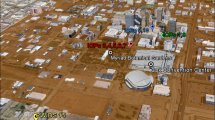Abstract
The Penn State/NCAR Mesoscale Meteorological Model 5 (MM5), Sparse Matrix Operator Kernal Emissions (SMOKE), and Community Multiscale Air Quality (CMAQ) modeling systems were employed to simulate ozone concentration distribution within the State of Arizona, in particular, Phoenix air basin, as supporting information to designate nonattainment areas of the U.S. Environmental Protection Agency's new 8-h ozone standard. In general, based on statistical comparisons between predictions and available (sparsely distributed) observations, the modeling system performed reasonably well for the Phoenix basin, thus proving it to be a useful tool for both regulatory as well as research applications. Detailed inspection, however, revealed a serious problem with respect to the details of the ozone distribution in that for some days the transition from downslope flow to upslope flow in the Phoenix basin was delayed in the model, causing the ozone distribution to show an unrealistic high-ozone bias toward the west valley. Implementation of a modified subgrid parameterization improved the time of transition, and hence the prediction of ozone and its precursor distributions. This study points to possible inadequacies of commonly used subgrid parameterizations in dealing with rapidly changing flow conditions such as morning (and evening) transitions.
Similar content being viewed by others
References
Berman, N. S., Boyer, D. L., Brazel, A. J., Brazel, S. W., Chen, R. R., Fernando, H. J. S. et al. (1995). Synoptic classification and physical model experiments to guide field studies in complex terrain. Journal of Applied Meteorology, 34, 719–730.
Brazel, A. J., Fernando, H. J. S., Hunt, J. C. R., Selover, N., & Hedquist, B. (2005). The evening transition and phenomena in Phoenix, Arizona and impacts of surface climate. Journal of Applied Meteorology, 44, 99–112.
Bright, D. R., & Mullen, S. J. (2002). The sensitivity of the numerical simulation of the Southwest monsoon boundary layer to the choice of PBL turbulence parameterization in MM5. Weather and Forecasting, 17, 99–114.
Ellis, A. W., Hildebrandt, M. L., & Fernando, H. J. S. (1999). Evidence of lower-atmospheric ozone “Sloshing” in an urbanized valley. Physical Geography, 20, 520–536.
Ellis, A. W., Hildebrandt, M. L., Thomas, W. M., & Fernando, H. J. S. (2000). Analysis of the climatic mechanisms contributing to the summertime transport of lower atmospheric ozone across metropolitan Phoenix, Arizona, USA. Climate Research, 15, 13–31.
Fast, J. D., Doran, J. C., Shaw, W. J., Coulter, R. L., & Martin, T. J. (2000). The evolution of the boundary layer and its effect on air chemistry in the Phoenix area. Journal of Geophysical Research, 105, 22833–22848.
Hanna, S. R., & Yang, R. (2001). Evaluation of mesoscale models' simulations of near-surface winds, temperature gradients, and mixing depths. Journal of Applied Meteorology, 40, 1095–1104.
Hong, S. Y., & Pan, H. L. (1996). Nonlocal boundary layer vertical diffusion in a medium-range forecast model. Monthly Weather Review, 124, 2322–2339.
Lee, S. M., & Fernando, H. J. S. (2004). Evaluation of meteorological models, MM5 and HOTMAC, using PAFEX-I data. Journal of Applied Meteorology, 43, 1133–1148.
Lee, S. M., Giori, W., Princevac, M., & Fernando H. J. S. (2006). Implementation of a stable PBL turbulence parameterization for the mesoscale model MM5: Nocturnal flow in complex terrain. Boundary-Layer Meteorology. DOI: 10.1007/s10546-005-9018-4.
Monti, P., Fernando, H. J. S., Princevac, M., Chan, W. C., Kowalewski, T. A., & Pardyjak, E. R. (2002). Observations of flow and turbulence in the nocturnal boundary layer over a slope. Journal of the Atmospheric Sciences, 59, 2513–2534.
O'Neill, S. M., & Lamb, B. K. (2005). Intercomparison of the community multiscale air quality model and CALGRID using process analysis. Environmental Science & Technology, 39, 5742–5753.
Otte, T. L., Pouliot, G., Pleim, J. E., Young, J. O., Schere, K. L., Wong, D. C. et al. (2005). Linking the eta model with the community multiscale air quality (CMAQ) modeling system to build a national air quality forecasting system. Weather and Forecasting, 20, 367–384.
Pielke, R. A., & Pearce, R. P. (1994). Mesoscale modeling of the atmosphere. Meteorological Monographs, 25(47), 156.
Ricchia, C. (2003). Testimony on behalf of ozone transport commission before the U.S. Environmental Protection Agency on its proposed rule to implement the 8-hour ozone national ambient air quality standard, 6 FR-32, June 7, 2003.
Sivacoumar, R., & Thanasekaran, K. (2001). Comparison and performance evaluation of models used for vehicular pollution prediction. Journal of Environmental Engineering, 127, 524–530.
Author information
Authors and Affiliations
Corresponding author
Rights and permissions
About this article
Cite this article
Lee, SM., Fernando, H.J.S. & Grossman-Clarke, S. MM5-SMOKE-CMAQ as a modeling tool for 8-h ozone regulatory enforcement: application to the state of Arizona. Environ Model Assess 12, 63–74 (2007). https://doi.org/10.1007/s10666-006-9053-7
Received:
Accepted:
Published:
Issue Date:
DOI: https://doi.org/10.1007/s10666-006-9053-7




